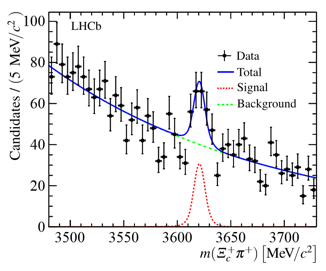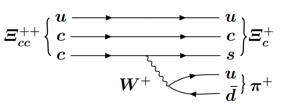[ m(Ξcc++) = 3621.55±0.23±0.30 MeV/c2 ]
A year ago the LHCb collaboration announced the observation of an exceptionally charmed particle, the Ξcc++ baryon. This particle contains two charm quarks and one up quark, resulting in an overall doubly positive charge. A month ago the collaboration has presented the first measurement of the lifetime of this baryon. Today LHCb physicists submitted for publication a new observation of this particle using a different decay channel.
The Ξcc++ was first observed via its decay into a Λc+ baryon and three lighter mesons K–, π+ and π+, with the Λc+ baryon decaying in turn into a proton p, a K– meson and a π+ meson. The Ξcc++ has now been “re-discovered” using a different decay, Ξcc++→ Ξc+π+ (see graph), in which the Ξc+ baryon decays into a proton, a K– meson and a π+ meson.
The left image shows the Ξc+π+ invariant mass distribution. The Ξcc++ peak is clearly visible, with a statistical significance of 5.9σ against the background-only hypothesis. The mass peak represents an independent observation of the Ξcc++ baryon, since the selected events are entirely different from those used in the previous study. The measured Ξcc++ mass is 3620.6±1.5±0.4±0.3 MeV/c2, fully consistent with the value of the previous measurement.
This measurement provides important information towards an improved understanding of the decays of doubly charmed baryons. Read more in the LHCb paper, and also in the CERN Update and the CERN Courier article.
21 November 2019 update: see Precision measurement of the Ξcc++ mass paper.


